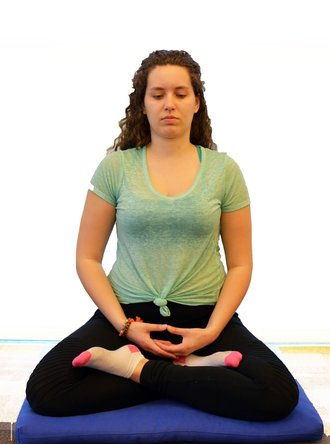
Yoga and meditation are both based on the principle of samadhi. This state of meditation is a state in which one-pointed attention is achieved. While the person is conscious and lucid, they have a deep awareness of the moment. This state of mind is different than other states, which require different levels. A form of mindfulness is required for those who want to attain samadhi.
The mind must be focused on one object for 12 consecutive breathing to achieve samadhi. While the mind might shift from one object or another during this period, it must remain focused on that object. When the mind completely focuses on one thing, samadhi will have come. It will feel as if your mind is one with the object. This will allow you to feel the object's essence.

The mind can achieve samadhi by staying in the body. The mind can be fully absorbed into an object, and then become aware of its essence. In this state, the mind is free of all thoughts and emotions. It's as if your mind has never left the object. When this happens, the mind becomes completely focused on the object and is unaware of any other objects. It is a profoundly spiritual experience.
The state of samadhi can be described as a deeply elevated state of awareness. However, it is not easy to achieve. Many people lack the spiritual disposition necessary to achieve it. They are simply unable or unwilling to enter the state. External sounds, email, or even a meeting could lead to an outside orientation. This is opposite to samadhi. This is a difficult and demanding way to return to samadhi.
Samadhi, a state of high concentration, is called Samadhi. According to the Yoga Sutras, the eighth limb is samadhi. Samadhi refers to a nondual, single-pointed state that allows people to gain insight in their experiences. In this state, the mind is integrated and cannot separate.

Meditation can help you achieve Samadhi, a state that allows you to focus on one thing at a time. It is a state where you focus your attention with one eye on an object of particular interest. It is the ultimate state of enlightenment, the final stage in the yoga path. It is the last step to true enlightenment or enlightenment. It is a state characterized by bliss and oneness. It is an excellent way to achieve a higher state consciousness.
Samadhi is the highest state of wholesome concentration. It is also associated with the word samatha (which means unperturbed mind) in the Yoga Sutras. However, this isn't the only way to achieve samadhi. A person can actually experience samadhi in many different ways. The most common method is to focus on an object for an extended period of time. This is the best way to reach samadhi.
FAQ
Which are the top 10 foods you should eat?
These are the top 10 foods to eat.
-
Avocados
-
Berries
-
Broccoli
-
Cauliflower
-
Eggs
-
Fish
-
Grains
-
Nuts
-
Oats
-
Salmon
What causes weight loss as we age?
How can you tell if your bodyweight has changed?
A person who has less body fat than their muscle mass will experience weight loss. This means that daily calories should be less than daily energy. The most common cause of weight loss is decreased activity levels. Other factors include stress, illness and pregnancy. If there is more body fat than muscle mass, then weight gain can occur. It occurs when people consume more calories per day than they need. It can be caused by overeating or increased physical activity as well hormonal changes.
Our bodies lose weight because we eat fewer calories than we burn. The main reason we lose weight is because we exercise more often. This increases our metabolism rate and burns more calories each day. However, this doesn't mean that we'll necessarily get thinner; what matters is whether or not we're losing fat or gaining muscle. If we're burning more calories that we consume, we'll lose weight. But if you consume more calories than you burn, you're actually storing them for fat.
As we age, we become less agile and don't move as often. We also tend not to eat as much food as we used to when we were younger. Therefore, we tend to put on weight. On the flipside, we are more muscular than we really need and appear bigger.
Without weighing yourself each week, there is no way to know how much weight you have lost. There are many ways you can measure your weight. You can gauge your waist size, hips, hips, thighs and arms. Some people prefer to use bathroom scales while others like to use tape measures.
For a better track of your progress, try to weigh yourself once per week and measure your waistline once every month. You can also take photos of your self every few months to track how far you've come.
You can also look up your height, weight and body measurements online to determine how much you weigh. If you're tall at 5'10", and weigh 180lbs, your weight would be 180.
What's the difference between a virus & a bacterium?
A virus can be described as a microscopic organism that cannot reproduce in another cell. A bacterium can be described as a single-celled organism which reproduces by splitting in two. Viruses measure only 20 nanometers in diameter, but bacteria is up to 1 millimeter in size.
Viruses are usually spread through contact with infected bodily fluids, including saliva, urine, semen, vaginal secretions, pus, and feces. Bacteria can be spread by direct contact with infected objects and surfaces.
Viral infections can also be introduced to our bodies by a variety of cuts, scrapes or bites. They can also be transmitted through the eyes, nose, mouth, ears, rectum, and anus.
Bacteria can enter the body through wounds. They can also be introduced to our bodies by food, water and soil.
Both viruses and bacteria can cause illness. Viruses can not multiply within the host. They infect only living cells, causing illness.
Bacteria can grow in their hosts and cause disease. They can spread to other parts of our bodies. Antibiotics are needed to eliminate them.
Statistics
- nutrients.[17]X Research sourceWhole grains to try include: 100% whole wheat pasta and bread, brown rice, whole grain oats, farro, millet, quinoa, and barley. (wikihow.com)
- Extra virgin olive oil may benefit heart health, as people who consume it have a lower risk for dying from heart attacks and strokes according to some evidence (57Trusted Source (healthline.com)
- WHO recommends reducing saturated fats to less than 10% of total energy intake; reducing trans-fats to less than 1% of total energy intake; and replacing both saturated fats and trans-fats to unsaturated fats. (who.int)
- WHO recommends consuming less than 5% of total energy intake for additional health benefits. (who.int)
External Links
How To
27 Steps to a healthy life when your family eats only junk food
It is easy to eat healthy when you cook at home. However, many people are not skilled in preparing healthy meals. This article will provide some helpful tips for making healthier dining out choices.
-
Choose restaurants that offer healthy options.
-
Order salads and vegetables before ordering any meat dishes.
-
Ask for sauces without added sugar.
-
Avoid fried foods.
-
Ask for grilled meats, not fried.
-
If you don't really need dessert, do not order it.
-
It is important to have something more after dinner.
-
Always eat slowly and chew your food thoroughly.
-
When you eat, drink plenty of fluids.
-
Don't skip breakfast and lunch.
-
Every meal should include fruit and vegetables.
-
Consume milk and not soda.
-
Try to stay away from sugary drinks.
-
Limit the amount of salt in your diet.
-
You should limit how often you visit fast food restaurants.
-
Ask someone to join if temptation is too much.
-
Don't let your children watch too much TV.
-
Do not turn on the television while you eat.
-
Avoid energy drinks
-
Regular breaks from work
-
Exercise early in the morning.
-
Do some exercise every day.
-
Start small and then build up slowly.
-
Set realistic goals.
-
Be patient.
-
Find time to exercise even if you don't feel like it.
-
Positive thinking is important.